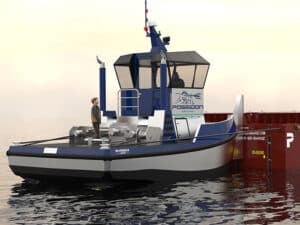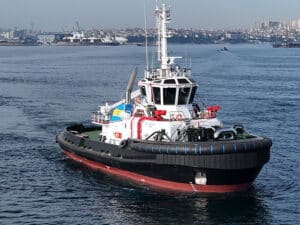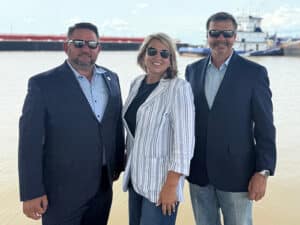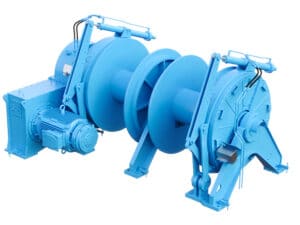
10 minutes with Russell Shrewsbury, VP of Western Towboat
Written by Heather Ervin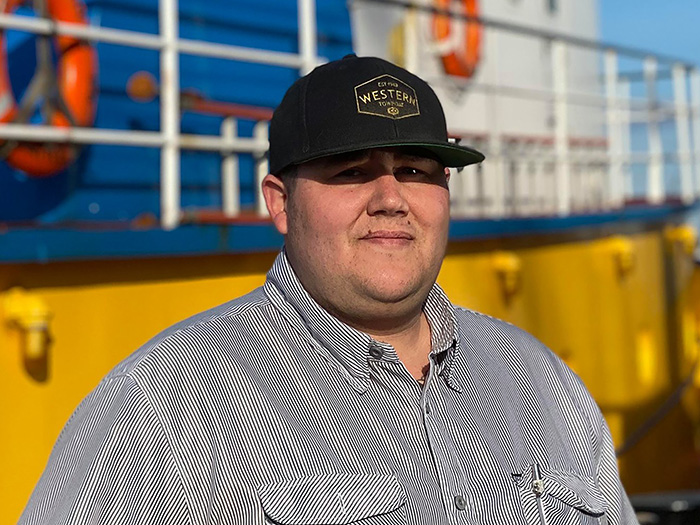
Russell Shrewsbury, vice president of Western Towboat Company. (Credit: Western Towboat Company)
As we approach TTB 2022, the industry’s only maritime event dedicated exclusively to the tug, towboat and barge sector, we wanted to talk to a provider of custom-built and designed tug and barge fleets.
As a family owned business in operation since 1948, Western Towboat Company, Seattle, Wash., has been operating tugs and barges from the Puget Sound to the Aleutian Islands, Arctic Alaska to the Hawaiian Islands, and all the way to the Panama Canal.
Russell Shrewsbury, vice president of Western Towboat, grew up sailing to Alaska on Western Towboat tugs. After graduating from California Maritime Academy in 2006, he went to work as Mate and then Captain, running company vessels around the Pacific Northwest and Alaska. In 2015, he assumed the role of vice president and relief captain.
Here’s more on Shrewsbury, his experiences working the waters of the West Coast, and on the milestones achieved by Western Towboat over the years.
Marine Log (ML): The company has been around for nearly 80 years. Can you tell us some of Western Towboat’s major milestones along the way?
Russell Shrewsbury (RS): Western Towboat has come a long way since our founding in 1948 by my grandfather Bob Shrewsbury Sr. As we close in on 75 years of operations our business has grown significantly in the last 40 years. We built our first tug Western Mariner in 1982. Around that time we transitioned out of our freight service to SE Alaska and sold that portion of the business to Lynden’s Alaska Marine Lines.
As Alaska Marine Lines business grew, so did Western Towboat. In 1997, we launched our first “Titan Class” tug, the Western Titan designed by Bob Shrewsbury Jr. Today, that design has been used by multiple companies in varying capacities. Moving into the 21st century, we have added seven Titan Class tugs into service.
In 2015, our ownership structure changed from Bob Sr.’s two sons, Bob and Ric, to just Bob Shrewsbury Jr.’s side of the family. This moved Western Towboat into the third generation of management with Bob Jr. and his three at the helm of the company.
ML: Western Towboat offers a variety of services, including ocean and harbor towing, ship assist, container and transportation services. Can you tell us more about your fleet and whether you provide additional tug, towboat or barge services?
RS: With a fleet of 24 tugs and seven barges of varying sizes, we offer just about every kind of service our customers may need. Our Titan Class ASD tugs service the Alaska freight markets, towing Alaska Marine Lines barges. Our other conventional tugs service a variety of markets utilizing our deck barges up to 10,500-short-ton capacity for heavy lift moves, aggregate, and one off cargo moves to worldwide destinations.
With a diverse fleet of equipment, it gives us the option to employ the correct vessel for whatever the job may call for. We have a fleet of four tractor tugs and conventional tugs from 1,200 hp. to 4,000 hp. that service the Pacific Northwest in many capacities from barge fleeting to special operations around local shipyards and ship assists around Puget Sound.
ML: Do you contract with other companies when building your vessels and barges? What are some unique features of the vessels and barges? I imagine each tug has varying interior specifications?
RS: We have solely been building tugs for ourselves since 1982, except for one tug we built for Lynden, our main customer in 2005. Our business has been growing fast enough where we really have only had time to build for ourselves and maintain our own fleet. Our tugs offer some unique attributes.
We have designed and built our own winches, towing pin boxes, and the ability to service our tugs with plug-and-play components to keep them on schedule with only minor downtime. Most of the systems on our vessels are interchangeable throughout the fleet (Caterpillar engines, Schottel/Rolls Royce drives) and operating systems so crews can be familiar when they go boat to boat.
ML: What would you say have been some of the biggest challenges to business over the last few years, and how do you see things changing in the years ahead?
RS: There have been some significant challenges the last few years with the implementation of Subchapter M. We will now need to be drydocking a vessel on average every 2.5 months. This creates a problem when there is limited availability of dry docks coupled with our scheduled runs.
To combat this, we are in the design phase of building our own dry dock to perform our own maintenance. With the growth of our fleet, we keep pretty busy maintaining everything with a small shipyard crew. The yard crew for us has an immense challenge of keeping everything moving as well as performing all rebuilds of engines, gears and most components in house. Another challenge has been the changing dynamics of the mariner.
The days of the mariner going to Alaska on a tugboat for long hitches without any communication is fleeing fast and schedules are king. As a company, we have found it important to listen to our crews, adapt and try and make this a company people are proud to work for that does not have an over the top management culture. We take great care in training our crews the right way and providing them with the best equipment and technology to get the job done safely and efficiently.
Moving ahead, we will continue to upgrade our fleet of tugs and keep growing in all aspects of our business while keeping it a family run operation.
ML: Finally, what’s new? Any newbuilds or other projects in the works that you can tell us about?
RS: Currently, we have a few things going on here. We are doing a complete rebuild of an older tug of ours, the Pacific. We added a complete new stern section to her and various upgrades interior wise, and we are about 40% complete on hull No. 20, which will be our eighth Titan Class tug and will be powered by C175 Caterpillar engines, Schottel SRP 490’s thrusters.
We anticipate this tug to be finished in Q1 2023. After that, we plan to build our own dry dock. The logistics of building that in our yard is going to be the hard part due to our small footprint, so we may be reaching out for some help to construct the dock sooner than later as our need for it grows by the day.

